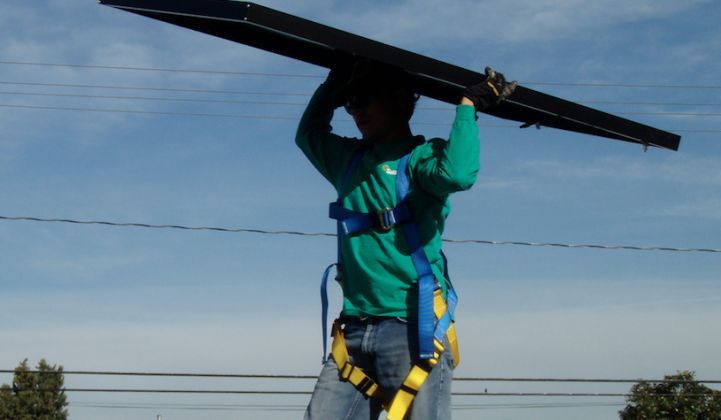The U.S. solar market is expected to achieve record installations in 2020 despite the impact of the coronavirus crisis, even as the distributed solar segment takes a big hit.
The U.S. solar market logged its largest first quarter of installations on record by a significant margin, according to new data released Thursday by Wood Mackenzie and the Solar Energy Industries Association. But the numbers confirm what the solar industry has feared: Distributed solar has been seriously affected the coronavirus, and no part of the industry has been entirely insulated.
The market is believed to be working through the most difficult stretch of the year right now. The first quarter overlapped only slightly with the full impacts of the coronavirus; the industry is now in the throes of the second quarter during which many states were shut down for months.
That hurdle comes after a record Q1 for the residential sector, which grew 42 percent year-over-year to 810 megawatts and nearly matched last year’s fourth quarter, which is traditionally the largest for solar installations. But things took a very different turn in the second quarter, when installations have likely been "severely hampered," WoodMac said.
“Residential is the most immediately impacted because [that segment's] sales and installation cycles are much shorter than commercial and utility-scale,” said Austin Perea, a senior solar analyst at WoodMac.
WoodMac expects residential solar installations to fall 25 percent year over year in 2020, hit by work stoppages, permitting delays and drops in consumer demand.
At the same time, large-scale installations continue to chug ahead and will drive the overall U.S. solar market to 33 percent growth in 2020, reaching 18 gigawatts. That's lower than the 20 gigawatts WoodMac predicted for 2020 before the virus, but it would still comfortably break the market's previous record year of around 15 gigawatts in 2016.
Still, much remains unclear as the virus continues spreading. WoodMac is assuming a 5 percent contraction in U.S. GDP in 2020 before it bounces back to 3 percent growth in 2021. Further waves of the virus and the subsequent economic response could change the outlook for solar.
“There’s a lot of uncertainty,” said Perea. “No one actually knows what the timeline on a vaccine looks like and how the virus will react once everyone reopens.”
Uneven impacts for the solar industry
What is certain is the uneven effect the pandemic has had on the solar industry. Solar companies have shed 72,000 jobs since the U.S. began experiencing the impacts of the virus, according to the Solar Energy Industries Association, but most of the strain has thus far fallen to home solar developers and installers. Though the industry’s national installers have not yet reported Q2 figures, some companies have noted declines in demand that exceed 50 percent.
Growing geographic spread in the residential solar industry may blunt some of the coronavirus’s impact on the residential market. States such as Florida, Texas and Colorado logged record quarters in Q1 and have begun reopening more aggressively than has California. A larger share of installations sited across a broader range of states means the potential for future shelter-in-place orders and second waves of the virus may only shut down a portion of the market.
In May residential installers began reporting an uptick in sales, but analysts caution that the second half of the year will not match pre-pandemic levels, as the industry confronts the potential for further spread of the virus and economic conditions that will depress overall consumer spending.
“Installers say there’s a rebound in demand; that is obviously true,” said Perea. “But it’s a rebound relative to the hit that they took in April. Some installers saw a 60 percent decline in their installations.”
That decline in demand is coming for commercial and industrial solar as well, but that segment's longer development cycles are expected to delay the most acute pain.
“On the C&I side, the impacts are going to be much longer-term,” said Perea. “The origination cycle right now is completely drying up, and folks are focusing on the execution of projects. Commercial interests are holding off on procuring.”
Not even the relatively resilient large-scale market completely dodged the effects of the pandemic. Numerous big projects will be completed on delayed timelines, though overall installations are forecast at 14.4 gigawatts, up from about 8.4 gigawatts last year.
That sector is the one expected to carry the overall industry to growth in 2020. Though the federal Investment Tax Credit steps down after 2022, WoodMac still expects that segment to average about 13 gigawatts through 2025. That's significant when compared to the large-scale segment's previous record of nearly 10.8 gigawatts installed in 2016.
Groups such as the International Energy Agency have pitched renewables as a tool for coronavirus recovery plans, but thus far that idea has gained little traction with U.S. policymakers.
***
Download the free executive summary of the latest U.S. Solar Market Insight report here.




